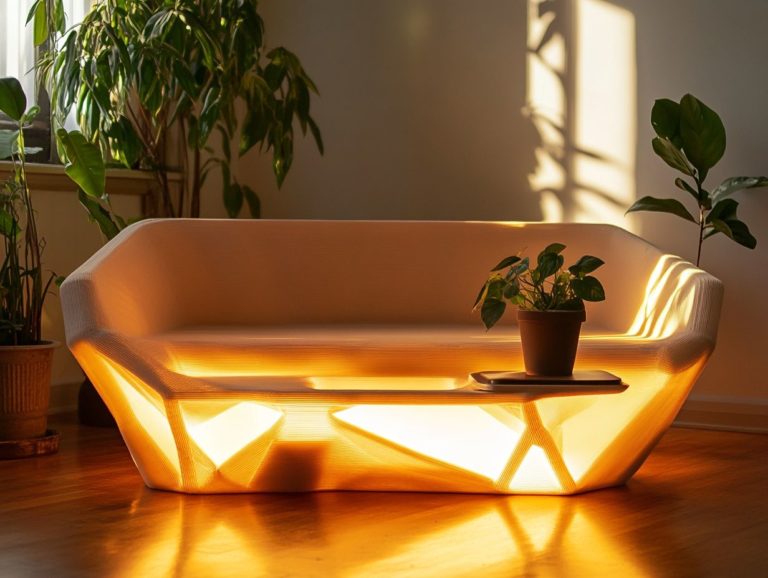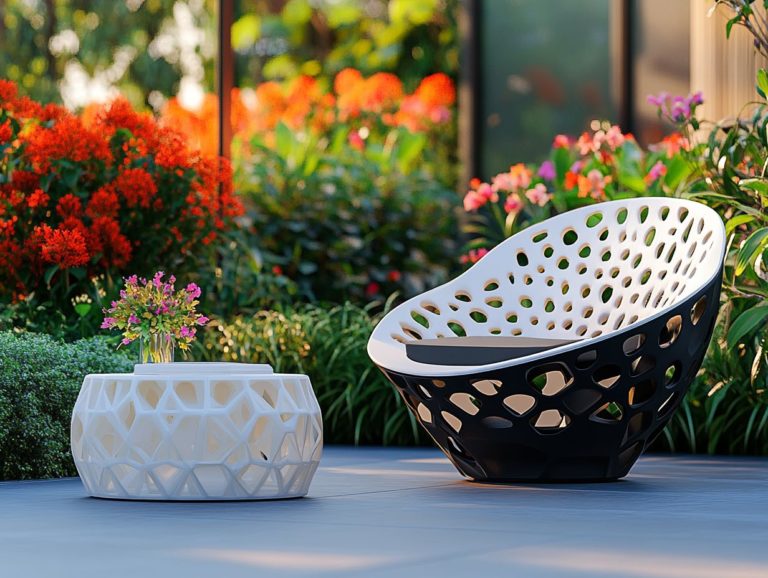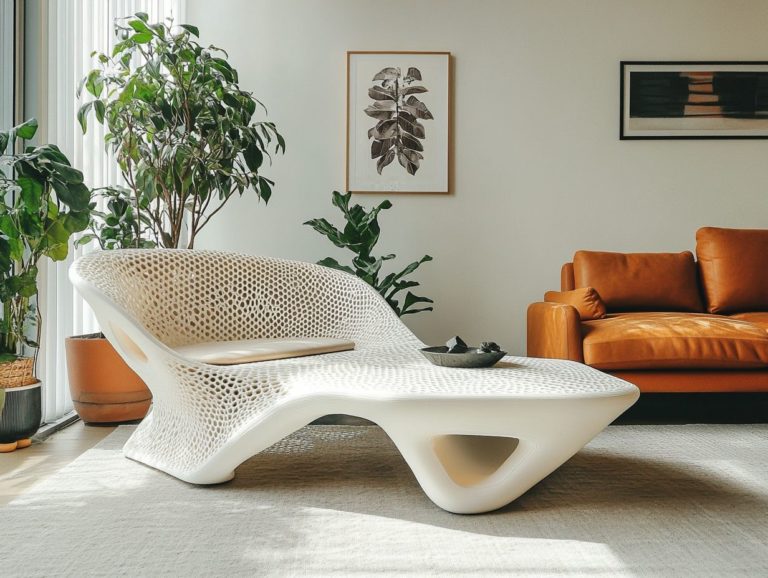3D-Printed Furniture: The Future of Home Design?
The world of furniture design is experiencing a significant change in the furniture industry with the emergence of 3D-printed furniture. This innovative approach enables you to create unique and customizable pieces while promoting sustainability in production.
As you delve into the history and evolution of 3D printing in furniture design, you’ll uncover its myriad advantages. These include cost-effectiveness and eco-friendliness. However, it’s essential to keep in mind the challenges and limitations that come with this technology.
Dive in and discover how 3D-printed furniture could transform your home design! Gaze into the future, where exciting innovations await.
Contents
- Key Takeaways:
- The Rise of 3D-Printed Furniture
- Advantages of 3D-Printed Furniture
- Potential Impact on Home Design Industry
- Challenges and Limitations of 3D-Printed Furniture
- Future Outlook for 3D-Printed Furniture
- Frequently Asked Questions
- Curious about 3D-printed furniture? Here s what you should know!
- What is 3D-printed furniture and how does it work?
- What are the benefits of using 3D-printed furniture in home design?
- Can 3D-printed furniture be as strong and durable as traditional furniture?
- Is 3D-printed furniture expensive?
- What are some examples of 3D-printed furniture?
- Is 3D-printed furniture environmentally friendly?
Key Takeaways:
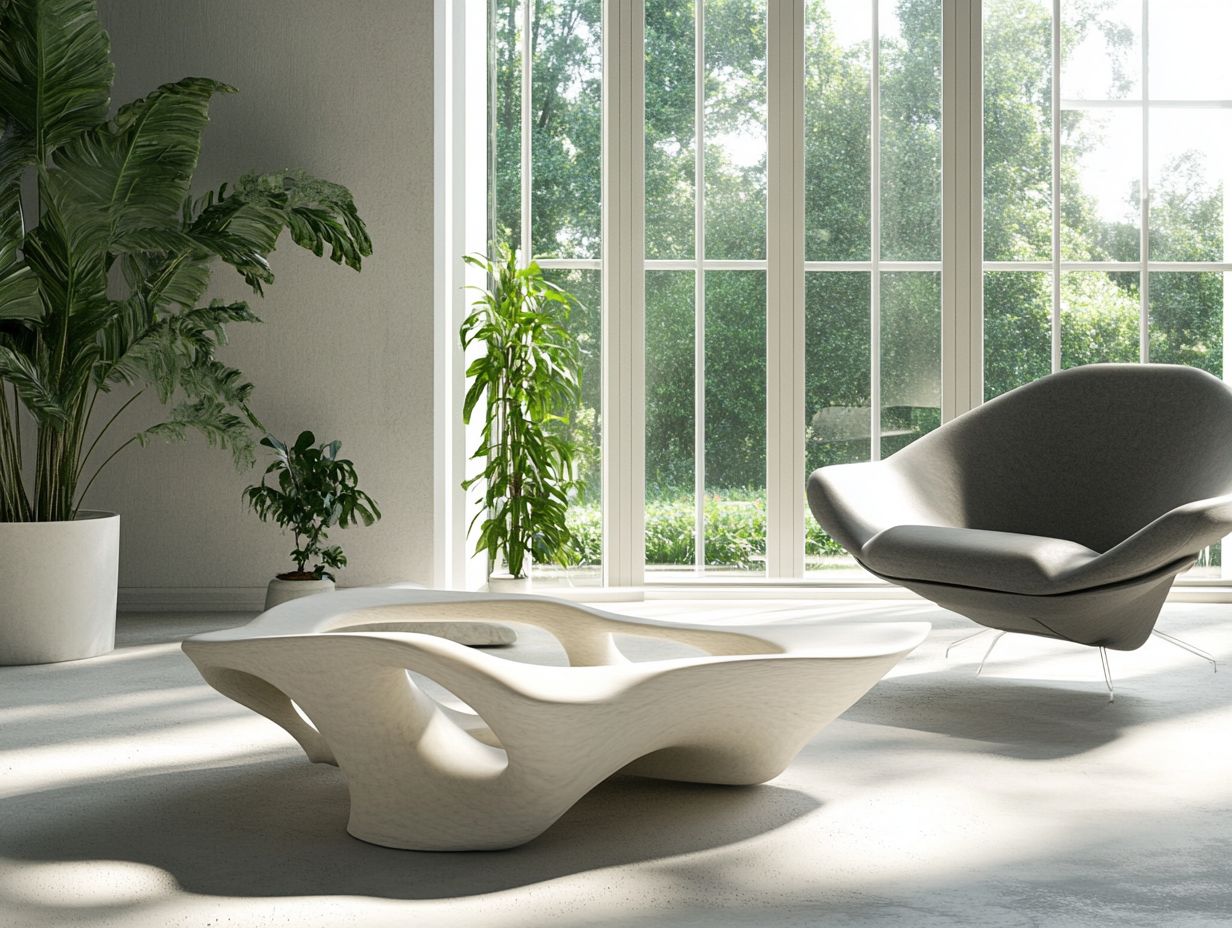
- 3D-printed furniture offers cost-effective and customizable designs, making it a promising solution for homeowners looking for unique pieces.
- This technology has the potential to reduce waste and promote sustainability in the industry.
- 3D-printed furniture could disrupt traditional design, opening doors for innovative and functional creations.
The Rise of 3D-Printed Furniture
The emergence of 3D-printed furniture signifies a significant change in the furniture industry, propelled by cutting-edge 3D printing technologies and evolving consumer preferences that emphasize customization and design freedom. To understand the financial implications, check out the cost of 3D-printed furniture and see if it’s worth it.
This groundbreaking approach enables the creation of distinct designs that were once beyond reach with traditional manufacturing methods, marking a new era in home decor and furniture production.
History and Evolution of 3D Printing in Furniture Design
The history and evolution of 3D printing in furniture design can be traced back to the groundbreaking work of Dr. Hideo Kodama at the Nagoya Municipal Industrial Research Institute. In the early 1980s, he introduced the concept of rapid prototyping, the initial stage of creating prototypes quickly and efficiently for testing, which laid the foundation for what would follow.
This initial innovation set the stage for a surge of developments, particularly in the late 2000s. Visionaries like Janne Kyttanen began crafting intricate and iconic pieces that highlighted the true potential of this technology. Companies such as Aectual emerged, pushing boundaries by creating furniture that emphasized appealing designs, prioritizing sustainability and customization.
As these advancements continued to challenge traditional manufacturing methods, they sparked a paradigm shift in furniture design. Designers were encouraged to explore more organic forms and functional versatility, transforming how consumers perceive and interact with their living spaces.
Advantages of 3D-Printed Furniture
The advantages of 3D-printed furniture are numerous. They offer unparalleled customization and design possibilities that align seamlessly with contemporary consumer preferences, highlighting the role of 3D-printed furniture in sustainable living.
This innovative approach enhances your aesthetic choices and fosters effective production and sustainability in processes, making it an ideal solution for the discerning individual.
Cost-Effective and Customizable Designs
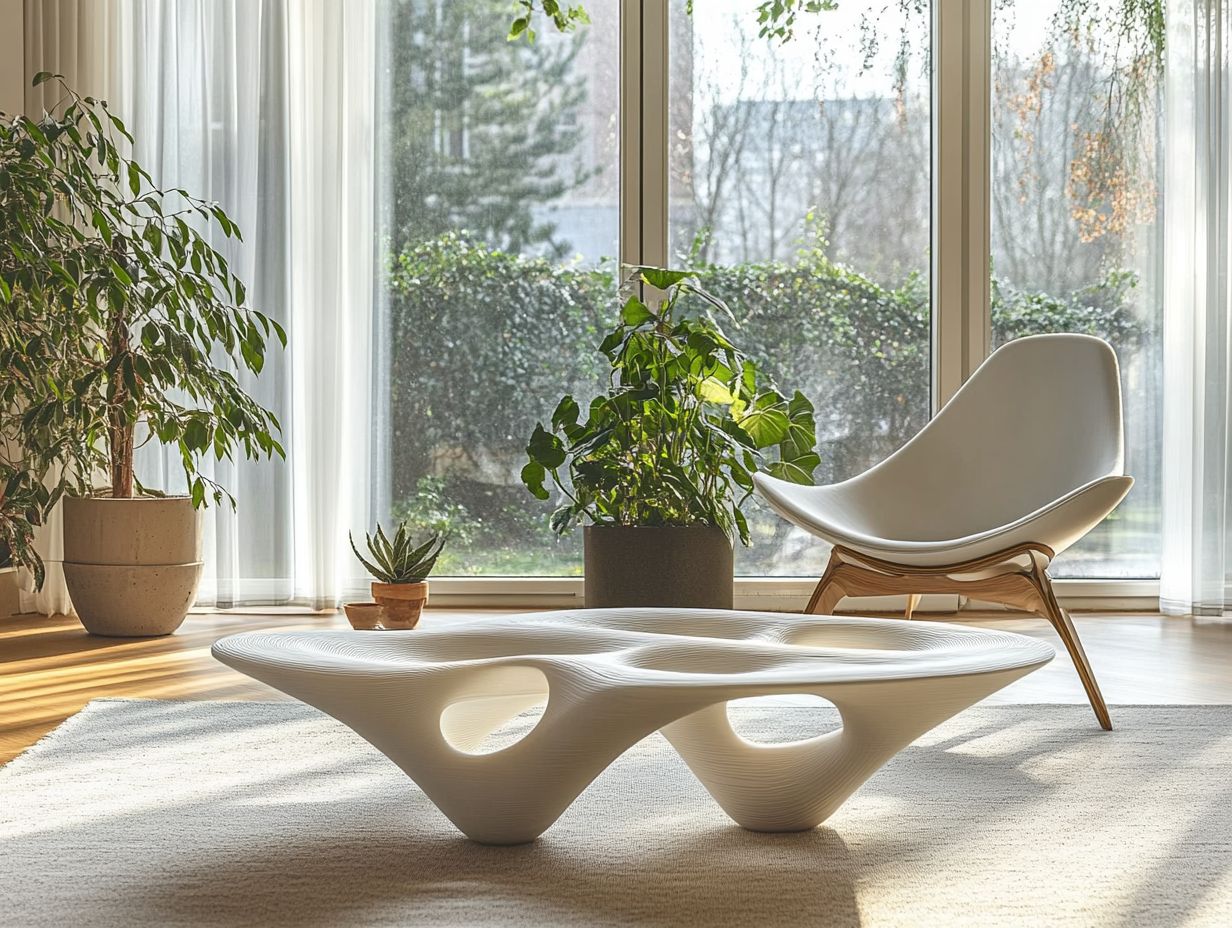
Cost-effective and customizable designs stand out as some of the most enticing advantages of 3D-printed furniture. You can tailor each piece to your specific needs and preferences, all while lowering overall production costs.
This innovative approach elevates personal expression and champions sustainability. Companies like Blu Dot and CustomMade provide platforms that enable you to create unique designs. By harnessing advanced 3D printing technology, these brands allow you to choose dimensions, materials, and styles, resulting in bespoke pieces that fit perfectly into your living spaces.
The reduction in material waste associated with 3D printing leads to a more efficient manufacturing process, minimizing excess while maximizing creativity. This shift towards personalized and eco-friendly furniture design, as explored in how 3D printing is changing the furniture industry, is becoming increasingly attractive to discerning consumers like you, who value both individuality and sustainability.
Sustainable and Eco-Friendly Production
Sustainable and eco-friendly production methods are essential to the allure of 3D-printed furniture. These approaches dramatically reduce material waste and utilize sustainable materials like bioplastics and thermoplastics.
This transition to innovative manufacturing techniques cuts down the carbon footprint associated with traditional furniture production often a process laden with extensive cutting and shaping and fosters a circular economy. Companies like Herman Miller seamlessly integrate 3D printing into their operations, achieving an impressive 70% reduction in waste generation. Research reveals that utilizing bioplastics sourced from renewable resources can yield a 30% decrease in carbon emissions during production.
By adopting these advancements, you can help the furniture industry play a pivotal role in environmental preservation while satisfying the growing consumer demand for sustainable products.
Potential Impact on Home Design Industry
The impact of 3D-printed furniture on the home design industry could transform the industry completely. This technology introduces disruptive changes that redefine your preferences as a consumer and pave the way for innovative designs tailored to various lifestyles and aesthetics.
Disruptive Changes and New Possibilities
Changes in manufacturing processes, particularly through 3D-printed furniture, unveil a realm of possibilities for you as a designer or consumer. This innovation enables you to craft designs that once existed only in your imagination.
This technology ignites your creativity and significantly reduces the time needed for rapid prototyping. Imagine transforming a conceptual piece into reality within days, allowing you to iterate quickly based on consumer feedback. The ability to produce intricate geometries that traditional manufacturing struggles with means your furniture can be visually stunning and functionally adaptable.
These advancements reshape market trends, as you and other consumers increasingly seek unique, customizable options that reflect personal style, ushering in a new era of expectations for greater personalization in everyday items.
Challenges and Limitations of 3D-Printed Furniture

Despite the numerous advantages that 3D-printed furniture offers, you may encounter several challenges and limitations, especially regarding technical and aesthetic aspects. These factors could significantly impede its wider use within the furniture industry.
Technical and Aesthetic Considerations
Technical and aesthetic considerations are crucial in determining the effectiveness of 3D-printed furniture. They directly influence both the feasibility of diverse designs and the overall appeal to consumers.
These aspects dictate the functional qualities of the item and shape its visual impact and tactile experience. For example, FDM is strong, but it may not provide a smooth look, while SLA offers exquisite detail at the expense of longevity. SLS enables the creation of intricate geometries, but the associated costs and recycling challenges can quickly deplete your resources.
Surface finishes and textures enhance aesthetics but introduce their own set of challenges that must be carefully balanced against the complexity of your design.
Future Outlook for 3D-Printed Furniture
The future of 3D-printed furniture holds immense promise for you, driven by swift innovations and advancements in manufacturing processes. Exploring the world of 3D-printed furniture design reveals how these developments are set to transform the furniture industry in ways you’ve never imagined.
Are you ready to explore the future of furniture design? The future of 3D-printed furniture is bright and full of potential. Don’t miss out on being part of this exciting revolution in home design!
Innovations and Advancements in the Field
Innovations and advancements in 3D-printed furniture are transforming design and manufacturing. This technology merges computer-aided design (CAD) software with advanced manufacturing techniques.
These developments push the boundaries of creativity. They enable the creation of complex geometries and intricate patterns that were once out of reach.
With sophisticated design software, you can visualize concepts in real-time. This makes adjustments easy and streamlines the prototyping process.
As a result, production efficiency soars. This dramatically reduces lead times and minimizes material waste.
This blend of technology and artistry enhances the uniqueness of each piece. It also promotes sustainable practices, creating a significant impact throughout the furniture industry.
Frequently Asked Questions

Curious about 3D-printed furniture? Here s what you should know!
What is 3D-printed furniture and how does it work?
3D-printed furniture is made by layering materials with a 3D printer. It builds items from a digital file.
What are the benefits of using 3D-printed furniture in home design?
You can customize 3D-printed furniture to fit your space. This reduces the need for mass-produced items and often saves money.
3D printing uses less material and creates less waste. This makes it a more sustainable option.
Can 3D-printed furniture be as strong and durable as traditional furniture?
Yes, it can be as strong as traditional furniture. Materials like plastic, metal, and wood composites are durable.
Is 3D-printed furniture expensive?
Prices vary by size and materials. Generally, 3D-printed options are cheaper because they waste less material.
What are some examples of 3D-printed furniture?
From chairs to entire homes, the possibilities are endless! Some companies even offer customizable options, allowing you to design unique pieces.
Is 3D-printed furniture environmentally friendly?
3D-printed furniture is eco-friendly! It uses fewer materials and often includes recycled resources, further reducing its environmental impact.


